Abstract
Physiologic concentrations of angiotensin II stimulate sodium transport by intestinal and renal early (S1) and late (S2) proximal tubule epithelial cells. We recently found that hydrogen ion secretion, which effects sodium bicarbonate absorption, was a transport function preferentially and potently increased by angiotensin II in S1 cells. S1 cells are normally responsible for half of the total renal hydrogen ion secretion. The mechanism by which angiotensin II regulates intestinal sodium transport is by potentiating sympathetic nerve activity and norepinephrine release. Direct control of hydrogen ion secretion by angiotensin II via receptors on epithelial cells has not been previously demonstrated. We now report that stimulation of in vivo hydrogen ion secretion in the rat early proximal tubule by angiotensin II was not mediated via change in nerve activity. Rather, enhanced hydrogen ion secretion by angiotensin II correlated with increased angiotensin II receptor density on epithelial cells in the early compared to late microdissected proximal tubule. Basolateral as well as luminal angiotensin II stimulated bicarbonate absorption. Angiotensin II reduced bicarbonate permeability and caused alteration in the apparent substrate affinity, but not maximal capacity, of the proximal hydrogen ion secretory system involving the Na+/H+ antiporter.
Full text
PDF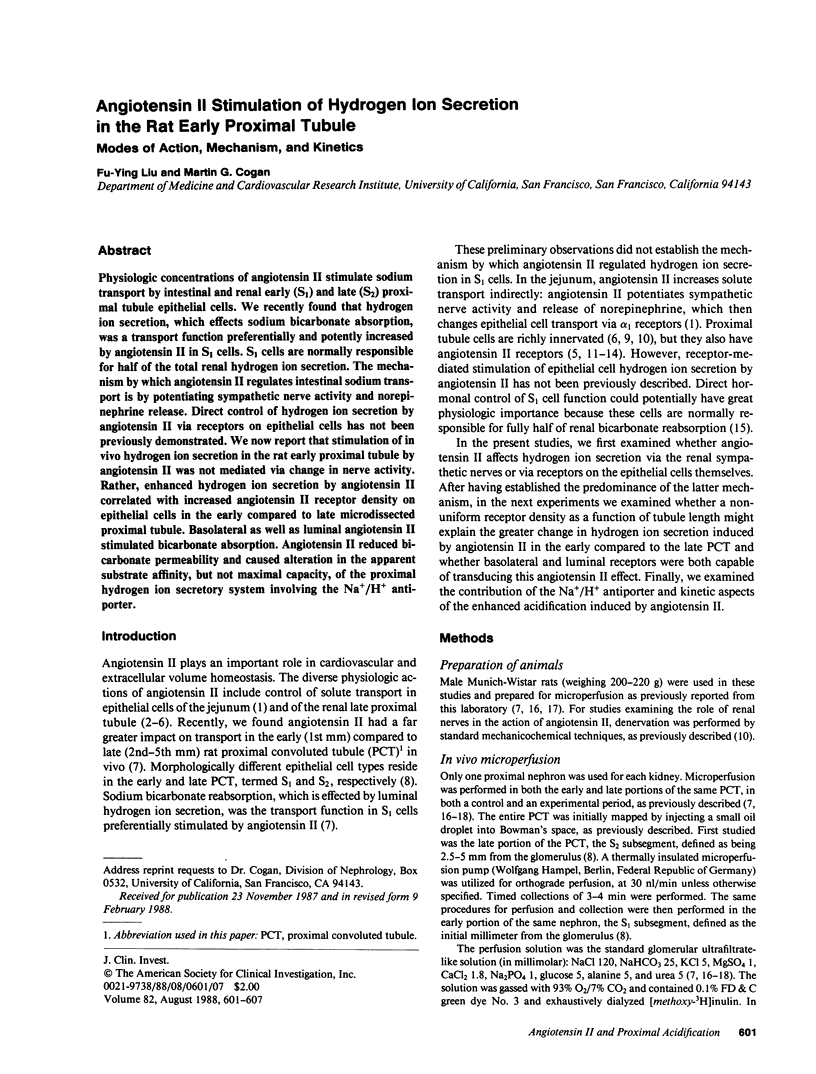
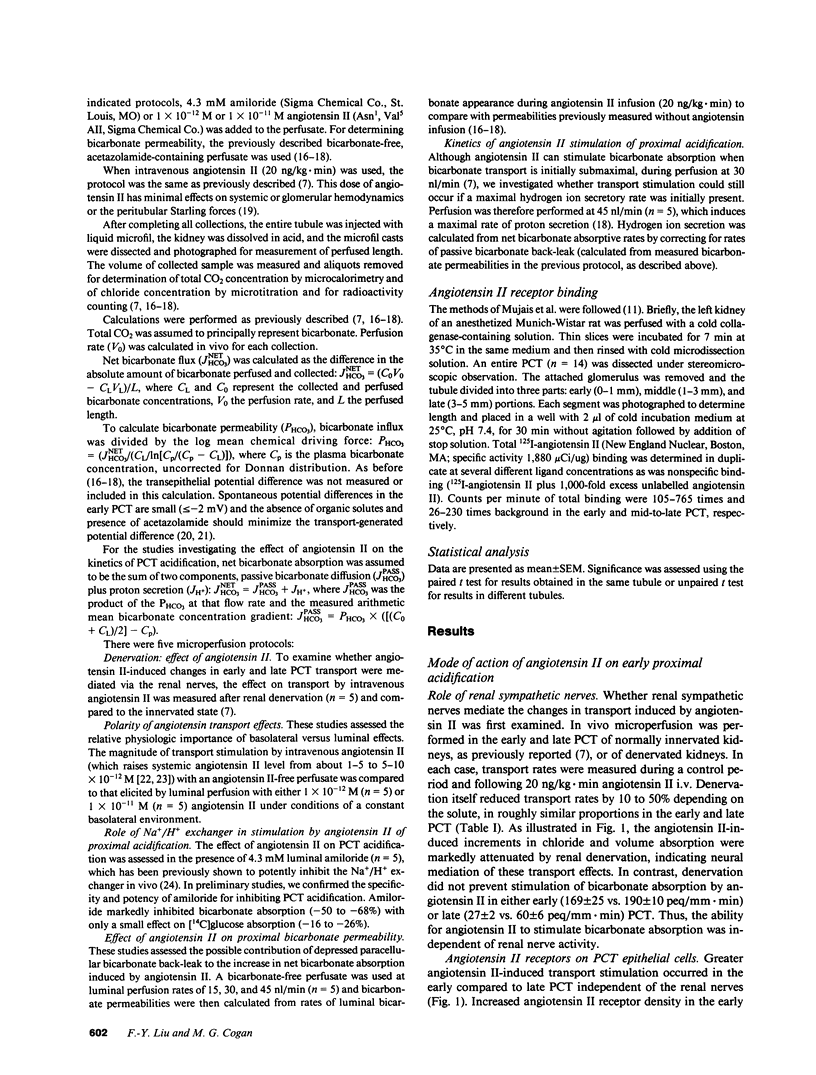
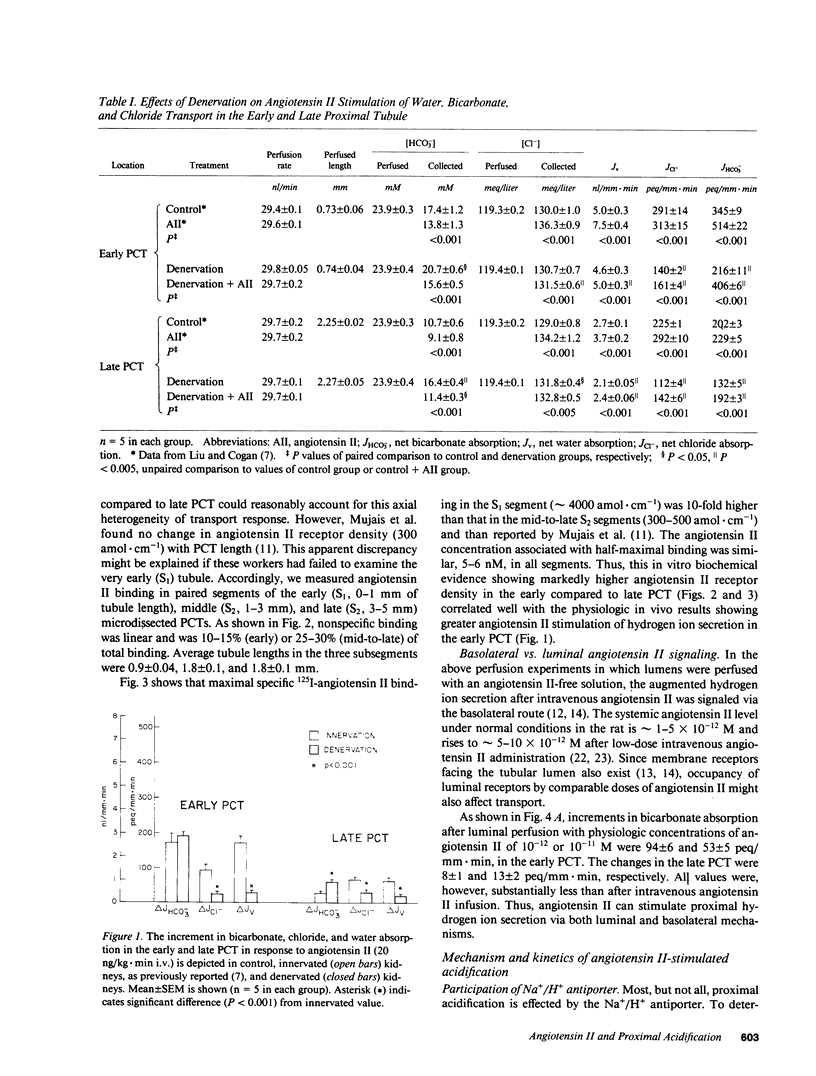
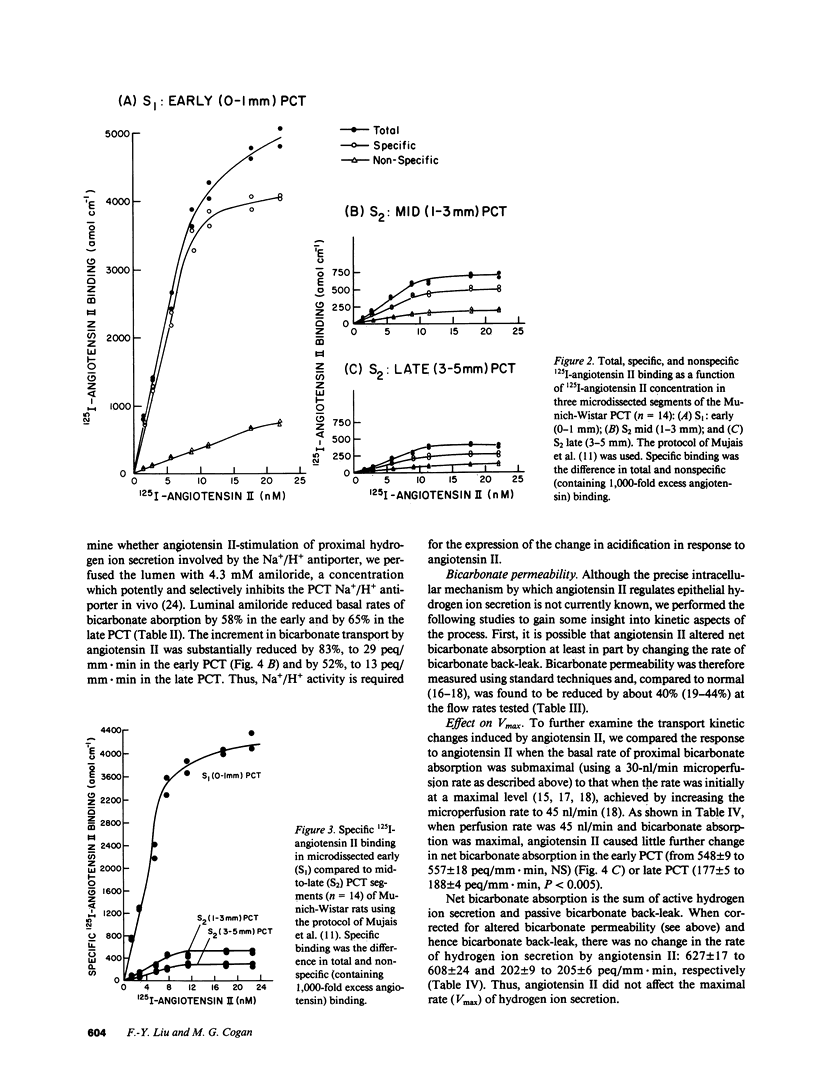

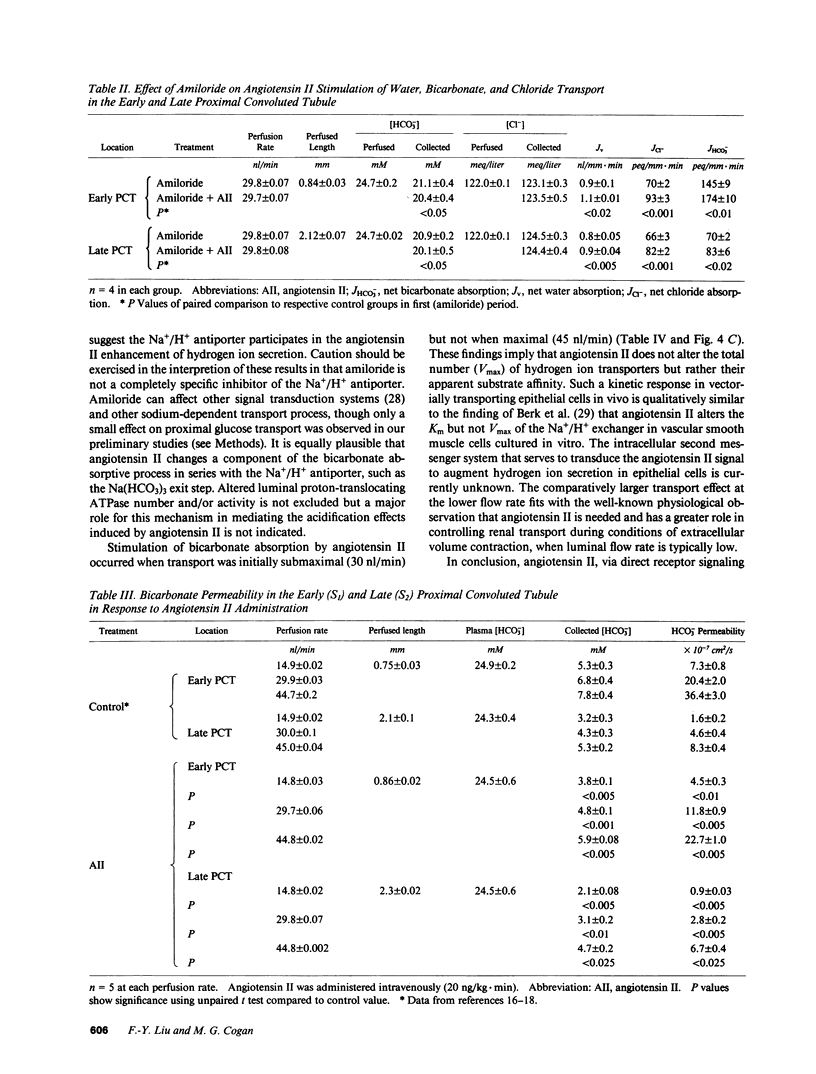

Images in this article
Selected References
These references are in PubMed. This may not be the complete list of references from this article.
- Barajas L. Innervation of the renal cortex. Fed Proc. 1978 Apr;37(5):1192–1201. [PubMed] [Google Scholar]
- Berk B. C., Aronow M. S., Brock T. A., Cragoe E., Jr, Gimbrone M. A., Jr, Alexander R. W. Angiotensin II-stimulated Na+/H+ exchange in cultured vascular smooth muscle cells. Evidence for protein kinase C-dependent and -independent pathways. J Biol Chem. 1987 Apr 15;262(11):5057–5064. [PubMed] [Google Scholar]
- Blantz R. C., Konnen K. S., Tucker B. J. Angiotensin II effects upon the glomerular microcirculation and ultrafiltration coefficient of the rat. J Clin Invest. 1976 Feb;57(2):419–434. doi: 10.1172/JCI108293. [DOI] [PMC free article] [PubMed] [Google Scholar]
- Brown G. P., Douglas J. G. Angiotensin II binding sites on isolated rat renal brush border membranes. Endocrinology. 1982 Dec;111(6):1830–1836. doi: 10.1210/endo-111-6-1830. [DOI] [PubMed] [Google Scholar]
- Brown G. P., Douglas J. G. Angiotensin II-binding sites in rat and primate isolated renal tubular basolateral membranes. Endocrinology. 1983 Jun;112(6):2007–2014. doi: 10.1210/endo-112-6-2007. [DOI] [PubMed] [Google Scholar]
- Cogan M. G. Neurogenic regulation of proximal bicarbonate and chloride reabsorption. Am J Physiol. 1986 Jan;250(1 Pt 2):F22–F26. doi: 10.1152/ajprenal.1986.250.1.F22. [DOI] [PubMed] [Google Scholar]
- Douglas J. G. Angiotensin receptor subtypes of the kidney cortex. Am J Physiol. 1987 Jul;253(1 Pt 2):F1–F7. doi: 10.1152/ajprenal.1987.253.1.F1. [DOI] [PubMed] [Google Scholar]
- Frömter E., Gessner K. Effect of inhibitors and diuretics on electrical potential differences in rat kidney proximal tubule. Pflugers Arch. 1975 Jun 26;357(3-4):209–224. doi: 10.1007/BF00585976. [DOI] [PubMed] [Google Scholar]
- Harris P. J., Navar L. G., Ploth D. W. Evidence for angiotensin-stimulated proximal tubular fluid reabsorption in normotensive and hypertensive rats: effect of acute administration of captopril. Clin Sci (Lond) 1984 May;66(5):541–544. doi: 10.1042/cs0660541. [DOI] [PubMed] [Google Scholar]
- Harris P. J., Navar L. G. Tubular transport responses to angiotensin. Am J Physiol. 1985 May;248(5 Pt 2):F621–F630. doi: 10.1152/ajprenal.1985.248.5.F621. [DOI] [PubMed] [Google Scholar]
- Harris P. J., Young J. A. Dose-dependent stimulation and inhibition of proximal tubular sodium reabsorption by angiotensin II in the rat kidney. Pflugers Arch. 1977 Jan 17;367(3):295–297. doi: 10.1007/BF00581370. [DOI] [PubMed] [Google Scholar]
- Imai M., Seldin D. W., Kokko J. P. Effect of perfusion rate on the fluxes of water, sodium, chloride and urea across the proximal convoluted tubule. Kidney Int. 1977 Jan;11(1):18–27. doi: 10.1038/ki.1977.3. [DOI] [PubMed] [Google Scholar]
- Levens N. R. Control of intestinal absorption by the renin-angiotensin system. Am J Physiol. 1985 Jul;249(1 Pt 1):G3–15. doi: 10.1152/ajpgi.1985.249.1.G3. [DOI] [PubMed] [Google Scholar]
- Liu F. Y., Cogan M. G. Acidification is inhibited in late proximal convoluted tubule during chronic metabolic alkalosis. Am J Physiol. 1987 Jul;253(1 Pt 2):F89–F94. doi: 10.1152/ajprenal.1987.253.1.F89. [DOI] [PubMed] [Google Scholar]
- Liu F. Y., Cogan M. G. Angiotensin II: a potent regulator of acidification in the rat early proximal convoluted tubule. J Clin Invest. 1987 Jul;80(1):272–275. doi: 10.1172/JCI113059. [DOI] [PMC free article] [PubMed] [Google Scholar]
- Liu F. Y., Cogan M. G. Axial heterogeneity of bicarbonate, chloride, and water transport in the rat proximal convoluted tubule. Effects of change in luminal flow rate and of alkalemia. J Clin Invest. 1986 Dec;78(6):1547–1557. doi: 10.1172/JCI112747. [DOI] [PMC free article] [PubMed] [Google Scholar]
- Liu F. Y., Cogan M. G. Flow dependence of bicarbonate transport in the early (S1) proximal convoluted tubule. Am J Physiol. 1988 Jun;254(6 Pt 2):F851–F855. doi: 10.1152/ajprenal.1988.254.6.F851. [DOI] [PubMed] [Google Scholar]
- Liu F. Y., Cogan M. G. Kinetics of bicarbonate transport in the early proximal convoluted tubule. Am J Physiol. 1987 Nov;253(5 Pt 2):F912–F916. doi: 10.1152/ajprenal.1987.253.5.F912. [DOI] [PubMed] [Google Scholar]
- Maunsbach A. B. Observations on the segmentation of the proximal tubule in the rat kidney. Comparison of results from phase contrast, fluorescence and electron microscopy. J Ultrastruct Res. 1966 Oct;16(3):239–258. doi: 10.1016/s0022-5320(66)80060-6. [DOI] [PubMed] [Google Scholar]
- Mujais S. K., Kauffman S., Katz A. I. Angiotensin II binding sites in individual segments of the rat nephron. J Clin Invest. 1986 Jan;77(1):315–318. doi: 10.1172/JCI112293. [DOI] [PMC free article] [PubMed] [Google Scholar]
- Pelayo J. C., Blantz R. C. Analysis of renal denervation in the hydropenic rat: interactions with angiotensin II. Am J Physiol. 1984 Jan;246(1 Pt 2):F87–F95. doi: 10.1152/ajprenal.1984.246.1.F87. [DOI] [PubMed] [Google Scholar]
- Preisig P. A., Ives H. E., Cragoe E. J., Jr, Alpern R. J., Rector F. C., Jr Role of the Na+/H+ antiporter in rat proximal tubule bicarbonate absorption. J Clin Invest. 1987 Oct;80(4):970–978. doi: 10.1172/JCI113190. [DOI] [PMC free article] [PubMed] [Google Scholar]
- Schuster V. L., Kokko J. P., Jacobson H. R. Angiotensin II directly stimulates sodium transport in rabbit proximal convoluted tubules. J Clin Invest. 1984 Feb;73(2):507–515. doi: 10.1172/JCI111237. [DOI] [PMC free article] [PubMed] [Google Scholar]
- Zimmerman B. G. Actions of angiotensin on adrenergic nerve endings. Fed Proc. 1978 Feb;37(2):199–202. [PubMed] [Google Scholar]



